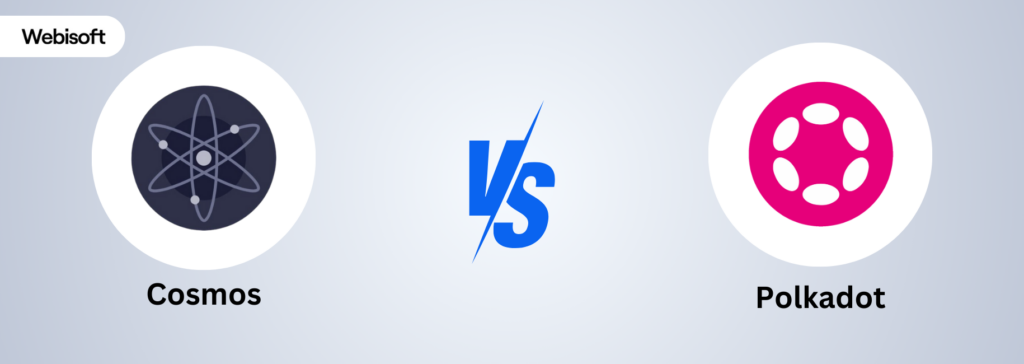Cosmos and Polkadot are like two big stars in the blockchain industry. Each promises to solve the pressing issue of blockchain interoperability.
However, Cosmos does this by creating a network that connects blockchains. It is kind of like how the internet connects computers. Polkadot uses a special setup called “parachains” that lets blockchains work together smoothly.
These platforms are really important because they make it possible for different blockchain networks to communicate. They are a must-have for the future of blockchain to grow and connect.
This article will take you through how Cosmos and Polkadot are tackling this challenge. Moreover, it will show you what makes each of them stand out, their benefits, and how they fit into the bigger picture of blockchain technology. So, keep going!
Contents
- 1 What is Cosmos?
- 2 What is Polkadot?
- 3 Cosmos vs Polkadot: The Similarities
- 4 Cosmos vs Polkadot: The Differences
- 5 Final Decision: Which One Should You Go Between Cosmos or Polkado
- 6 Is There Any Better Alternative to Cosmos And Polkadot?
- 7 Final Note
- 8 FAQs
- 8.1 How do Cosmos Crypto and Polkadot (DOT) differ regarding investment potential?
- 8.2 Is Polkadot or Cosmos better for new blockchain developers?
- 8.3 In comparing DOT vs ATOM, which shows more promise for future growth?
- 8.4 How does Webisoft help in deciding between Cosmos and Polkadot?
- 8.5 Can Cosmos and Polkadot be used together in a project?
What is Cosmos?
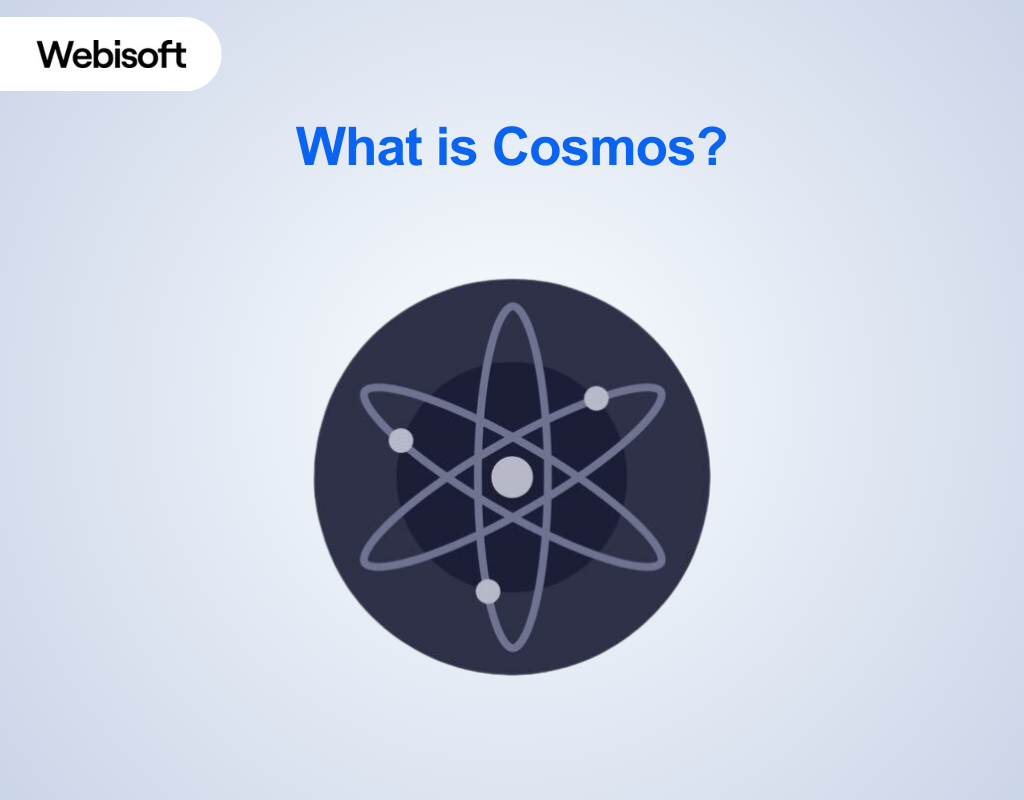
Cosmos is known as the “Internet of Blockchains”. It is a technology that aims to solve big problems in the blockchain world. It makes things quicker, easier to use, and better at connecting different blockchain systems.
However, Cosmos creates a space where many blockchains can run on their own but still talk to each other easily. It’s special because it lets different blockchains keep their independence while sharing information and transactions.
This ability to work together is made possible by using open-source tools such as Tendermint, the Cosmos SDK, and the Inter-Blockchain Communication (IBC) protocol. These tools help Cosmos lead the way in building a network of blockchains.
Pros and Cons of Cosmos
Let’s explore the advantages and drawbacks of Cosmos:
| Pros | Cons |
| Enhances interoperability among blockchains | Complexities in inter-blockchain communication |
| High scalability and customization options | Still changing, less proven compared to older blockchains |
| Strong security with tendermint consensus | Network size smaller than established blockchains |
| User-friendly for developers and users | |
| Decentralized and independent blockchains | |
| Reduces blockchain isolation and increases efficiency |
What is Polkadot?
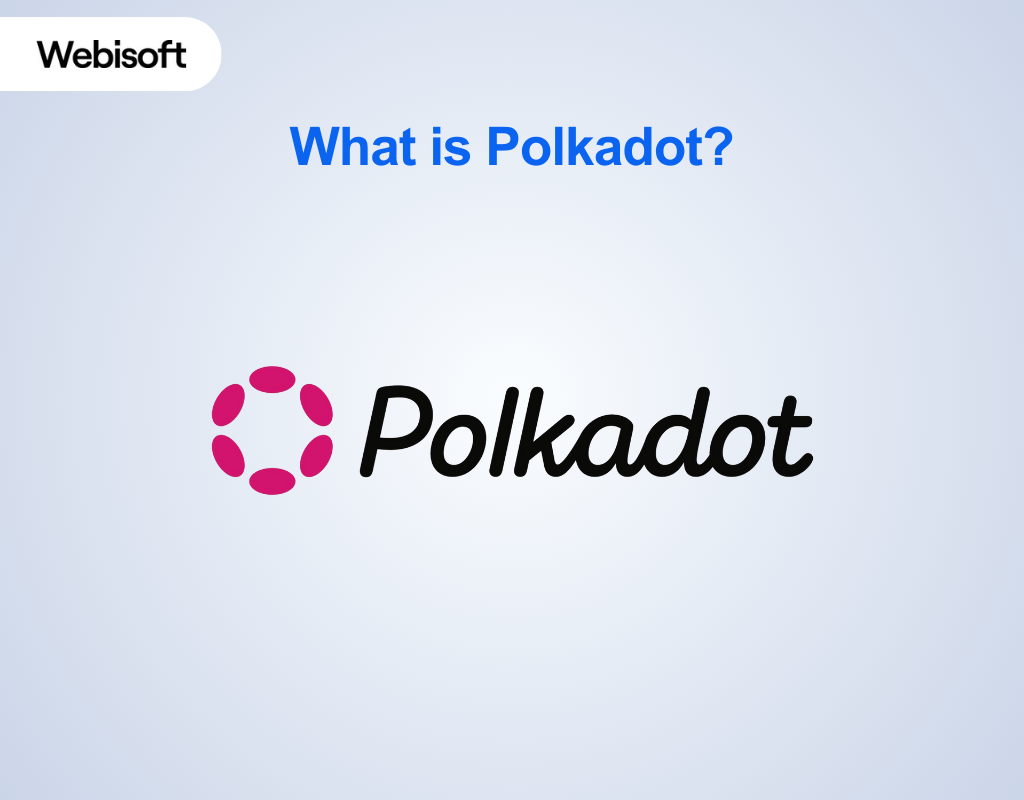
Polkadot is a great platform that allows different blockchains to connect and communicate. However, Polkadot creates a unified environment where many blockchains can work together as one big ecosystem.
This setup makes it possible to keep your data and transactions private, safe, and linked across different blockchains. Also, Polkadot’s design means that many transactions can happen at the same time on different chains, speeding things up.
Pros and Cons of Polkadot
The advantages and challenges of Polkadot are:
| Pros | Cons |
| Enhanced interoperability and scalability | Technical complexity for new users |
| Parallel processing for increased efficiency | Requires significant investment for network security |
| Strong security through shared security model | Dependent on network growth for full potential |
| Encourages innovation with customizable blockchains | |
| Facilitates easy upgrades and forkless updates |
Cosmos vs Polkadot: The Similarities
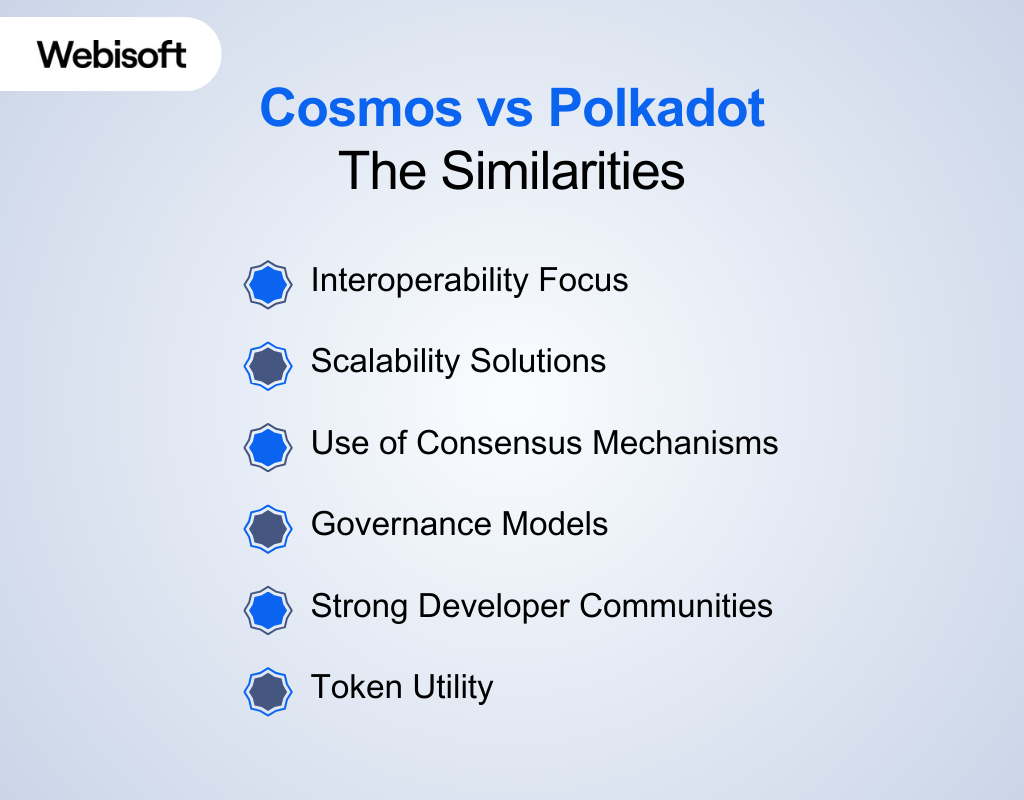
The similarities between Cosmos and Polkadot are:
Interoperability Focus
Cosmos and Polkadot both aim to solve a big blockchain issue: interoperability. They want to make a network where blockchains can talk and share info easily. This breaks down barriers, creating a more connected and efficient system.
Scalability Solutions
Scalability is a huge challenge they both tackle. They know for blockchain to really take off, it needs to handle a ton of transactions fast and securely. Their designs are built to do just that, without slowing down or risking security.
Use of Consensus Mechanisms
To keep things secure and running smoothly, Cosmos and Polkadot use special consensus methods. Cosmos has Tendermint, and Polkadot uses Nominated Proof of Stake (NPoS). These help make sure every transaction is checked and added correctly across all blockchains.
Governance Models
Cosmos and Polkado both platforms take governance seriously, giving their users a say in decisions. This democratic way lets people suggest, vote on, and make changes. All these keep the platforms growing with their communities.
Strong Developer Communities
A big part of what makes a blockchain platform successful is its developers. Both Cosmos and Polkadot have dedicated, active developer communities. These folks are always working on making things better and adding new features, keeping both platforms cutting-edge.
Token Utility
Lastly, the native tokens (ATOM for Cosmos and DOT for Polkadot) are key to more than just transactions. They’re also used in governance and helping secure the network. This makes these tokens valuable tools in how each platform operates.
Cosmos vs Polkadot: The Differences
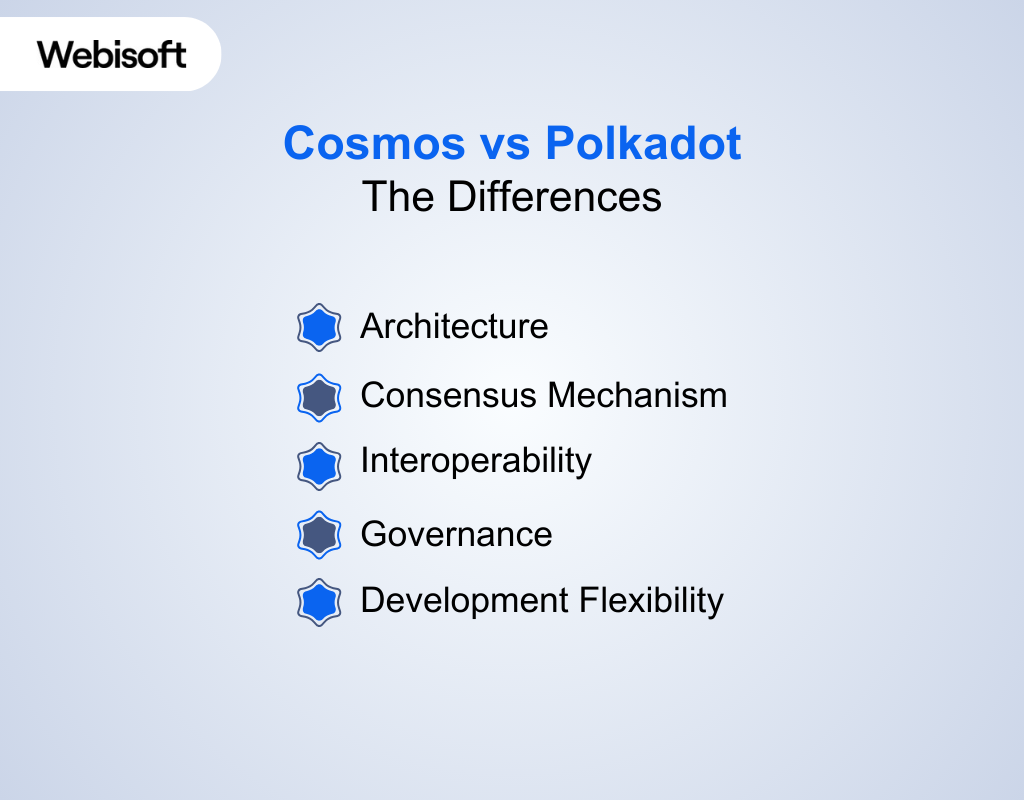
Now, let’s comprehensively compare Cosmos vs Polkadot, exploring key differences that set them apart.
| Aspect | Cosmos | Polkadot |
| Architecture | Hub-and-spoke model with independent blockchains | Relay chain with interconnected parachains |
| Consensus Mechanism | Byzantine Fault Tolerance (BFT) variants | Nominated Proof of Stake (NPoS) |
| Interoperability | Inter-Blockchain Communication (IBC) | Cross-Chain Message Passing (XCMP) |
| Governance | Independent governance for each blockchain | Shared governance across the network |
| Developer Flexibility | High, with customizable blockchains | Moderate, within the confines of Substrate |
Now, it’s time to explore all the above differences in more detail. Let’s start:
Architecture
Cosmos is built like a hub with spokes, where each spoke is an independent blockchain, or “zone,” connecting to a central hub. This lets each blockchain have its own rules but still be part of a larger network.
On the flip side, Polkadot uses a central relay chain that connects various “parachains.” Each comes with its special features but shares the relay chain’s security.
Consensus Mechanism
Cosmos lets each blockchain choose its consensus mechanism, often using different types of Byzantine Fault Tolerance (BFT). This setup offers customization for securing different chains.
However, Polkadot uses a unified approach called Nominated Proof of Stake (NPoS). It focuses on network security and efficient decision-making centralized around its relay chain.
Interoperability
For Cosmos, interoperability comes from the Inter-Blockchain Communication (IBC) protocol. It lets different chains send data and tokens to each other.
However, Polkadot achieves this with Cross-Chain Message Passing (XCMP). It enables parachains to interact securely without needing to trust each other.
Governance
In Cosmos, each blockchain governs itself, meaning it can have its own rules for making decisions. Polkadot operates with a collective governance model that applies to the whole network. Moreover, it affects all parachains connected to the relay chain.
Developer Flexibility
Cosmos offers a lot of freedom for developers, letting them build customized blockchains using the Cosmos SDK. On the contrary, Polkadot provides a good amount of flexibility too, through its Substrate platform. But it standardizes some features across all parachains.
Final Decision: Which One Should You Go Between Cosmos or Polkado
The choice between Cosmos and Polkadot hinges on the specific needs of your blockchain project.
However, is Polkadot or Cosmos better? Which one you should go for in the following discussion will clarify.
Choose Cosmos If
Pick Cosmos if you want each blockchain in your network to be independent and customizable. It’s great if you aim to build a network of blockchains that can work on their own but still talk to each other.
However, Cosmos is also a good fit if you need a blockchain personalized to your specific needs, especially regarding governance or unique features. For scalability, Cosmos’s IBC protocol is a strong point.
Choose Polkadot If
Go with Polkadot if your priority is a scalable, interoperable platform with a shared security model. It suits projects planning to create multiple blockchains (parachains). Moreover, it can easily interact while enjoying the security of the Polkadot relay chain.
However, Polkadot is beneficial if you’re using its interoperability and security for projects involving many blockchains.
Is There Any Better Alternative to Cosmos And Polkadot?
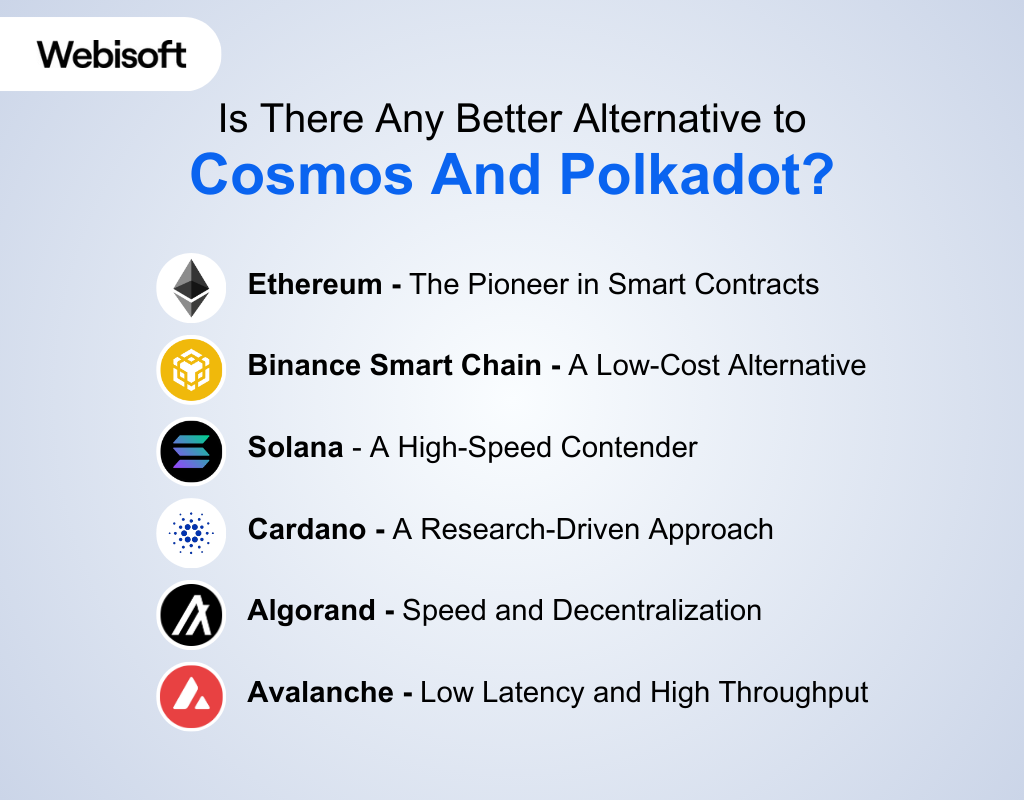
Cosmos and Polkadot have made significant strides in blockchain technology. However, several other platforms offer compelling features if you’re exploring alternatives.
Let’s explore alternative options, each providing unique benefits that might suit your needs.
| Feature/Platform | Ethereum | Binance Smart Chain | Solana | Cardano | Algorand | Avalanche |
| Consensus Mechanism | PoW (transitioning to PoS) | PoSA | PoH/PoS | Ouroboros PoS | Pure PoS | Avalanche PoS |
| Transaction Speed | Moderate (higher post PoS transition) | High | Very High | Moderate to High | High | High |
| Scalability | Moderate (higher post PoS transition) | High | Very High | High | High | High |
| Smart Contract Support | Extensive | Extensive | Extensive | Extensive | Yes | Extensive |
| Unique Features | DeFi, widespread adoption | Low fees, high throughput | High throughput, low fees | Academic approach, formal verification | Eco-friendly, fast finality | High throughput, subnets |
| Decentralization | High | Moderate | Moderate | High | High | Moderate |
| Security | High | High | High | High | High | High |
Ethereum – The Pioneer in Smart Contracts
Ethereum is a top pick for many because it’s great at handling smart contracts. It has a big community and is widely used, which makes it dependable.
Despite some issues with handling lots of transactions at once, it’s getting better with updates. Ethereum is also very flexible for developing different apps.
Binance Smart Chain – A Cost-Effective Platform
If you’re worried about high fees, Binance Smart Chain is a good choice. It works well with Ethereum’s tools, making it easy for developers to switch over.
However, it’s becoming popular for finance projects because it’s affordable and works fast, without giving up on having a secure network.
Solana – The Speedster of Blockchain
Solana is renowned for its impressive processing speed. It can easily handle thousands of transactions per second, eclipsing many competitors.
This speed and lower costs make Solana ideal for high-frequency trading platforms. Developers favor Solana for applications requiring rapid transaction processing.
Cardano – Emphasizing Sustainability
Cardano is different because it really focuses on being sustainable and scalable. It’s very secure thanks to its careful, research-based approach.
However, Cardano is constantly getting better. And it is attractive for projects that are in it for the long haul, especially with its commitment to being eco-friendly.
Algorand – Innovating with Pure Proof-of-Stake
Algorand uses a special consensus method that makes it very secure and fair. It’s fast and efficient at processing transactions. Thus it becomes a good option if security and fairness are important to you.
Avalanche – Low Latency and High Throughput
Avalanche is noted for its ability to process a lot quickly and with minimal delay. It’s a scalable choice that fits a wide range of applications. Also, its unique consensus method means transactions are confirmed quickly. Moreover, it is appealing to those who want speed and security.
Final Note
In wrapping up the Cosmos vs Polkadot debate, it’s clear that both platforms have their strengths and weaknesses.
Cosmos gives you more freedom and is best if you want to build things your way. Polkadot is better if you’re looking for a secure, integrated system. Simply, what you choose depends on what you need for your project.
However, if you want to make an informed decision and connect the full potential of either Cosmos or Polkadot, reach out to the Cosmos developers of Webisoft.
FAQs
How do Cosmos Crypto and Polkadot (DOT) differ regarding investment potential?
The investment outlook can change with market trends. Cosmos lets its blockchains be more independent. On the other hand, Polkadot’s connected systems might attract those looking for cohesive growth.
Is Polkadot or Cosmos better for new blockchain developers?
Polkadot might be simpler for newcomers because of its unified system. On the other hand, Cosmos requires understanding how its blockchains work together..
In comparing DOT vs ATOM, which shows more promise for future growth?
Both DOT (Polkadot) and ATOM (Cosmos) have good chances for growth. It depends on how they change to meet blockchain’s future needs.
How does Webisoft help in deciding between Cosmos and Polkadot?
Getting expert advice can help. It’s about breaking down the technical stuff into something easier to understand. So you can pick one based on what your project needs.
Can Cosmos and Polkadot be used together in a project?
Yes, they can be combined. Use Cosmos for its flexible blockchain networks and Polkadot for seamless interaction between those networks. Both of them offer a full solution for blockchain projects.
